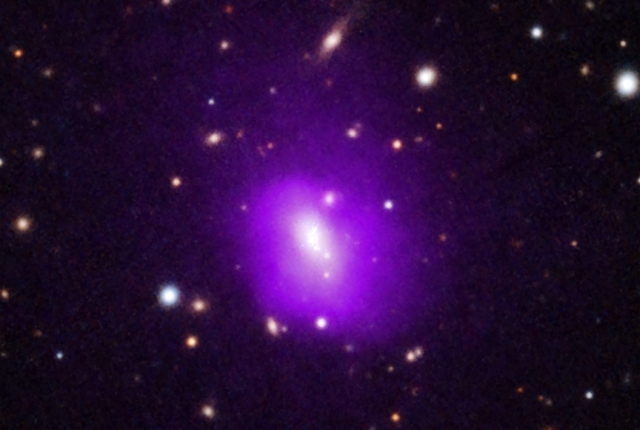Plasma jets ejected by black holes can change direction

Image: X-ray: NASA/CXC/Univ. of Bologna/F. Ubertosi; Inset Radio: NSF/NRAO/VLBA; Image Processing: NASA/CXC/SAO/N. Wolk
The powerful plasma jets that are ejected by black holes can change direction, as if the black holes were spinning on themselves in an unpredictable manner. The discovery - presented in an article in The Astrophysical Journal - comes from an international research team led by scientists from the University of Bologna and the National Institute of Astrophysics - INAF.
The researchers observed the behaviour of 16 black holes found at the centre of galaxies surrounded by hot gas. Each black hole ejects two extremely powerful plasma jets in opposite directions, travelling at speeds close to the speed of light.
Using data from the Very Long Baseline Array (VLBA), one of the world's largest interferometric radio telescopes, the scientists analysed the direction of these plasma jets at a distance of several light-years from the centre of the galaxies from which they originated. This allowed them to monitor their current direction.
Then, using the Chandra X-ray Observatory, a NASA orbital telescope that observes the sky in X-rays, they analysed the pairs of cavities, or bubbles, which form when jets of plasma pass through the region of hot gas around galaxies. This allowed the researchers to compare the directions of these previously generated cavities with those of plasma jets several light years away.
"About a third of the plasma jets we analysed point in completely different directions than in the past", explains Francesco Ubertosi, a researcher at the 'Augusto Righi' Department of Physics and Astronomy at the University of Bologna and first author of the study. "Like the Death Star from Star Wars, these black holes seem to rotate and point their beam in new directions".
The results show that the plasma jets can change direction by up to almost 90 degrees in a time span of one million to several tens of millions of years. Considering that the observed black holes are probably more than ten billion years old, these changes in direction are relatively fast.
"Plasma jets ejected by black holes and the cavities created by their passage through hot gas play an important role in the process of new star formation within galaxies", adds Myriam Gitti, professor at the 'Augusto Righi' Department of Physics and Astronomy, who participated in the study. "The passage of these plasma jets injects energy into the hot gas in and around the galaxies, preventing it from cooling and therefore slowing down the star formation process: if the plasma jets also change direction, they can affect larger areas of the galaxies, further inhibiting the birth of new stars".
Now, the question is: how do black holes rotate like this? It is thought that the direction of the plasma jets is aligned with the axis of rotation, following a line that connects the two poles of the black holes. At the same time, there is an accretion disk around the black holes, on which much of the gas and matter that falls into them is concentrated.
"The flow of matter that accumulates in the accretion disc and precipitates into the black hole probably causes the jet of plasma that is ejected from the black hole to be perpendicular to the disk", explains Fabrizio Brighenti, professor at the 'Augusto Righi' Department of Physics and Astronomy and one of the authors of the study. "However, if other material falls into the black hole at different angles to the accretion disk, this could eventually affect the axis of rotation of the black hole and deflect the plasma jet in a different direction".
The study was published in The Astrophysical Journal under the title 'Jet Reorientation in Central Galaxies of Clusters and Groups: Insights from VLBA and Chandra Data'. Participating for the University of Bologna and the National Institute of Astrophysics - INAF were Francesco Ubertosi, Myriam Gitti and Fabrizio Brighenti. Scientists from the Center for Astrophysics | Harvard & Smithsonian (USA) and the Naval Research Laboratory (USA) also took part.






